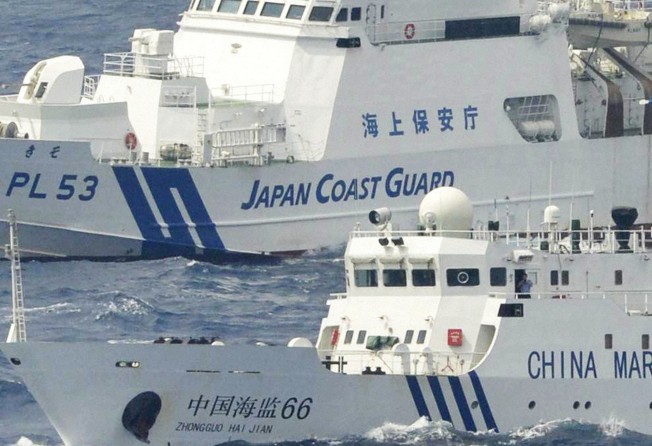
East China Sea tensions rise as Chinese coastguard overshadows Japanese mayor’s ‘symbolic’ trip to disputed Diaoyu/Senkaku islands
- Tokyo has lodged a diplomatic protest with Beijing and ordered Chinese ships to stay out of its territory after two coastguard ships entered waters near the island chain
- The incident coincided with the first trip to the islands by the mayor of Ishigaki, the Japanese municipality that administers the uninhabited islands

Chinese coastguard ships reportedly approached a Japanese vessel in a disputed area of the East China Sea on Monday, overshadowing a “symbolic” visit to the area by a local mayor.
The presence of the Chinese coastguard ships in waters surrounding a group of disputed islands known in Japan as the Senkakus but in China as the Diaoyus has raised diplomatic temperatures and prompted Tokyo to lodge a complaint with Beijing.
It came almost a year to the day after Beijing introduced a new law allowing its coastguard to use weapons against foreign vessels operating in areas claimed by China and prompted warnings from analysts that the possibility of an accidental clash between vessels from the two countries was rising.
News of the incident emerged after Yoshitaka Nakayama, the mayor of Ishigaki – the Okinawan municipality that administers the five uninhabited islands – sailed for the islands aboard the Bosei Maru, a vessel commissioned by the city government to carry out an oceanographic survey off three of the islands. Nakayama was paying his first trip to the islands, although he chose not to go ashore at any point, instead opting to view the islands of Uotsuri, Kita Kojima and Minami Kojima from the vessel before returning to Ishigaki 170km to the south.
That visit itself could be seen as provocative: Tokyo has consistently refused to grant permission for anyone to go ashore out of concern that such a move could provoke China into an aggressive response. Even so, the city of Ishigaki in 2020 altered the name of the administrative area that covers the islands and applied to the national government for officials to be permitted to land to erect new stone markers bearing the new official name of the territory.

Toshimitsu Shigemura, a professor of international relations at Tokyo’s Waseda University, described the mayor’s visit as “symbolic” and an appeal to the “emotions of local people”, saying it was “designed to send a message to both Tokyo and Beijing”.
“He is showing China that his local government is exercising control over the islands and that they are Japanese territory, while he is also telling Japan that more must be done to protect this part of the nation,” Shigemura said.
The Japanese government later revealed that shortly before 6.30am on Monday morning – about the same time as the Bosei Maru was in the area – two Chinese coastguard ships had entered territorial waters around Minami Kojima and attempted to approach a Japanese vessel. However, it did not make clear whether it was referring to the Bosei Maru.
Japan responded angrily to the incident, with Chief Cabinet Secretary Hirokazu Matsuno informing a press conference that Tokyo had issued a formal protest with Beijing through diplomatic channels, adding that the ships had been ordered to leave Japanese waters immediately. He added that the incident was “regrettable and unacceptable.”
The Chinese ships left Japan’s territorial waters, which extend 12 nautical miles from the coastline, at around 10.20am but were still within the contiguous zone, which extends a further 12 nautical miles, later in the day. The Chinese ships are being shadowed by Japanese coastguard vessels and have been instructed not to enter the territorial waters again.
This is the second time this year that mainland Chinese ships have entered Japanese territorial waters surrounding the Diaoyu/Senkakus, which are also claimed by Taiwan.

Patrick Hein, a lecturer in political science at the Tokyo University of Foreign Studies, said China wanted “to show that it does not recognise Japanese control over the islands”, even as Japan increases the deployment of military forces in the region, including on Ishigaki and neighbouring Yonaguni Island.
Shigemura of Waseda University said he did not anticipate any further confrontations for the next few weeks as Beijing was focused on making sure that the Winter Olympic Games went off without any major incidents.
Meanwhile, on Tuesday reports emerged that the former Tokyo governor Shintaro Ishihara had died aged 89. Shintaro had provoked a bitter diplomatic row between Japan and China in 2012 by announcing a plan for the Tokyo metropolitan government to buy a major part of the disputed Diaoyu Islands from a private Japanese owner. The plan led the central government to eventually buy three of the islands, resulting in a freeze in bilateral relations and tensions that have lasted to this day.